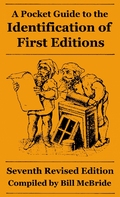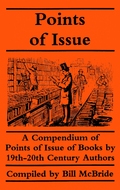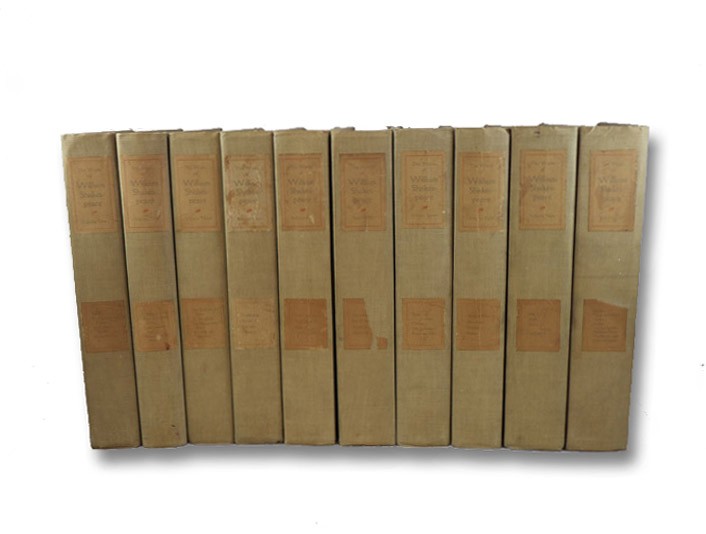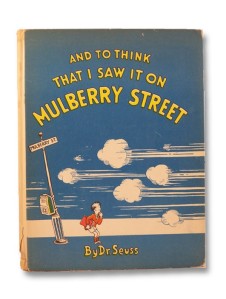One of the basic skills the novice collector (not to mention the novice bookseller) needs to learn is how to properly identify first editions. Depending on the book, and the publisher, this can be a very simple task, or quite complicated. Within this article I will do my best to provide a series of steps you can use to verify the edition of the book(s) in question. I’ll also recommend a number of handy references that you’ll want to acquire if you are serious about collecting or bookselling.
First, look at the book. It seems obvious, but you would be surprised how often books are bought based on a belief that they are something they, in fact, are not, simply because the buyer did not look closely enough at the book. I can say this without any fear of appearing judgmental, because I have been a good example of this phenomenon numerous times myself. In the words of one of my colleagues with a knack for brevity, “We all allow our hearts to get the best of our heads every now and then.”
And so, I say again, look at the book. Are there any indications that this is a reprint, or a book club edition? (More on this later.) Statements such as ‘the bestselling novel, now with a new introduction’ or ‘over 1 million copies sold’ on the dust jacket are dead giveaways (though it is rarely this easy). Who is the publisher, and what date is listed on the copyright page? Based on the general appearance of the book, does this date make sense? Many reprint publishers simply reuse the printing plates from other editions, without adding information about when the reprint occurred. Other reprint publishers list no date at all. Still others produce facsimiles of original editions, sometimes providing separate information about the reissue on a different page; sometimes not. With some practice handling books on a regular basis, you will learn which publishing companies were reprint outfits (Grosset & Dunlap; Henry Altemus; M.A. Donohue; John Lovell), and which tended to release originals (Macmillan; Putnam; Scribner; Little, Brown). As with most rules of thumb, there are exceptions to these tendencies, but it is far more efficient to learn the exceptions than to discard the rule.
I mentioned book club editions earlier. These are hardcover editions reprinted either by the original publisher, or by special arrangement between this publisher and another. These are often a slightly stockier format than trade edition hardcovers, and are not considered collectible editions except in very limited circumstances. ‘Book clubs’ or ‘BCEs’ often bear certain distinguishing characteristics: 1) lack of a list price on the jacket, sometimes accompanied by a statement of Book Club Edition on the front jacket flap; 2) inexpensive boards [generally paper over boards instead of cloth]; 3) a small blind stamp on the corner of the rear board [often a square or a circle, which is sometimes colored in]. Some book clubs masquerade very convincingly as trade editions, though, so make sure to follow the other steps in this article even if your book does not match these criteria.
If the book passes muster so far, step two is to check it against references. I find Bill McBride’s A Pocket Guide to the Identification of First Editions (pictured below) an invaluable resource. In a compact 142-page paperback, he supplies identifying characteristics of first editions for hundreds of publishers. And, despite a peculiar tendency of ‘pocket’ guides to be anything but, this one will fit quite easily in one’s back pocket, so there’s no excuse not to have it on-hand when shopping at bookstores, antique malls, or book fairs. It will pay for itself quickly by saving you money on mistakes. We offer copies for sale at our shop, and it can also be ordered directly from the author quite easily. Common identification points listed here range from obvious designations (e.g., ‘states first edition on copyright page’; ‘states First published in <year>’) to rather complex uses of jargon (e.g., one publisher uses a two-digit code to represent month and year). You will find yourself memorizing the simple ones if you use the guide frequently.
A check of what is now in the trade simply called McBride’s should let you know that either 1) it’s not a first edition; 2) you don’t have enough information to determine this definitively. Again, there are exceptions to rules. In addition, there are sometimes states within an edition that make identifying true first editions a bit more difficult. So, just because the conventions stated in McBride match does not necessarily mean it is a first edition in every case. I could get into a larger discussion about states, but this is a subject unto itself, so sufficed to say that sometimes identification points for first editions can get complicated. Two useful references to consult in these instances are www.fedpo.com, and another guide by McBride entitled Points of Issue (pictured below). These often provide minutiae related to particular titles that can be used to authenticate a first edition. For Fitzgerald’s The Great Gatsby, there are several typographical errors in the text that indicate a first edition. Sometimes the price listed on the jacket is a point of issue (i.e., a detail that helps differentiate a first edition from other imprints).
If these references do not provide enough information to make a definitive assessment, it may be necessary to locate a bibliography that treats the work specifically. A number of subject-based bibliographies, and bibliographies of specific authors, are available, and these often differ quite a bit in format. Some are basically checklists, and provide little information regarding bibliographic details or differentiation of editions. Others, collectively known as descriptive bibliographies, are exhaustive publication histories of known versions of works on certain subjects, or by certain authors. These are often the best available reference, and as a result bibliographies for particularly sought-after authors and subjects can be quite expensive. Again, though, they make up for this cost by helping us avoid acquiring books that are not, in fact, first editions, though represented as such (and in today’s world of online bookselling, this is a valid concern, as many transactions are happening sight-unseen, between individuals that have not met one another).
The first edition of And to Think That I Saw It on Mulberry Street we featured in our blog recently was authenticated using a bibliography of Dr. Seuss’s works written by Younger & Hirsch. This is a work that is readily available in various reprints, but sought after by collectors because it is Seuss’s first book.
If you determine that the book you have is a first edition, then your assessment of value should involve comparing it against other first editions. Other factors (e.g., author signature; condition; lack/presence of dust jacket; etc.) may play a role in this as well. But generally, determining whether you have ‘the real thing’ is one of the largest steps towards figuring the value. If you do your research online, you will of course need to apply again some of the steps detailed above to make sure that other people offering first editions for sale have actually done their homework. Do not simply trust websites to return only first editions because you clicked the ‘First Edition’ box when searching. Watch out for phrases like ‘First book club edition’ (which is on the edge of being deliberately misleading). ‘First thus’ is another one that can trip you up here, but this generally refers to the first printing of a work that was published previously, but has been updated to include new information or features (e.g., illustrations), or sometimes to the first appearance of a work in book form (as distinct from appearance in serial form – think Charles Dickens).
So, to summarize:
1) Look at the book – is it a reprint or a book club edition?
2) Check your references – does it follow the conventions that publisher used to designate first editions?
3) Invest in a bibliography.
Once you have followed these three steps, you should have a good idea whether you have a first edition. If it is a book you own, congratulations! If it is a book you intend to buy, do some research to see whether the price is reasonable; if so, and you can afford it, and it matches any other guidelines you generally follow when collecting… buy it! If it is a book you would like to sell, visit your local secondhand book shop to see if they would be interested in purchasing it, or try to sell it yourself. Make sure not to misrepresent what you have, though, and be sure to mention your research.
If the above still leaves you wondering what you have, contact a local bookseller, or consider inquiring with one of the trade organizations associated with collectible books. These are the ABAA (Antiquarian Booksellers’ Association of America) and IOBA (Independent Online Booksellers Association). For those located outside the United States, try ILAB (International League of Antiquarian Booksellers) – this is the worldwide organization of which the ABAA is the American chapter. Booksellers are, in large part, very congenial and helpful in this regard. And if you find that the one you choose to contact is not, worry not… There are plenty of us, so just try the next one on the list; it is important that those you deal with in the book trade are people with whom you feel comfortable, and who display that they are trustworthy.
Jonathan Smalter, Bookseller
President, Yesterday’s Muse Books
Vice President, IOBA
Sellers of fine books in all categories, with specialties in:
Castles & Military Fortifications; Dystopian Literature
32 W Main St Ste 1
Webster, NY 14580
Phone: (585) 265-9295
www.websterbookstore.com
https://musebooks.wordpress.com
www.facebook.com/yesterdaysmuse
www.twitter.com/ymbookseller
http://pinterest.com/yesterdaysmuse/
www.linkedin.com/in/yesterdaysmuse/

Worth every penny.

 Booths were bustling with activity throughout the day as customers inquired about books on display, or asked questions about their own collections. We purchased a number of items ourselves, including a first American edition of George Orwell’s Homage to Catalonia, a set of Shakespeare’s works in an attractive silk-lined publisher’s case, and a small collection of travel literature featuring decorative cover designs by A. & C. Black publishers.
Booths were bustling with activity throughout the day as customers inquired about books on display, or asked questions about their own collections. We purchased a number of items ourselves, including a first American edition of George Orwell’s Homage to Catalonia, a set of Shakespeare’s works in an attractive silk-lined publisher’s case, and a small collection of travel literature featuring decorative cover designs by A. & C. Black publishers.





